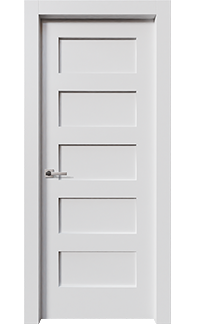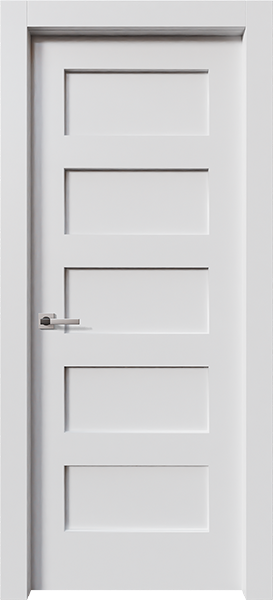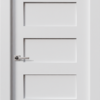Description
THE DOOR NAME ORIGIN – “SHAKER STYLE 5 EQ PANEL”
The design of this interior door is in keeping with the Shaker philosophy of favoring simple yet highly dependable functionality over complex structures with what the original craftsmen viewed as excessive ornamentation, inlays, embellishments, and so forth. Throughout history, simplicity has come back into fashion because there is only so much complexity the human eye can take without getting, well, weary of it.
Simplicity can be quite elegant, not to mention that it almost invariably costs less. This is true in architecture, fashion, and even science, and it is most certainly true when it comes to buying interior doors. Shaker craftsmen were well aware of this. In the middle of the Nineteenth Century, at the peak of their movement, when their influence was spreading rapidly westward from New England, it wasn’t for lack of funds that they stuck to their themes and ideas; it was a matter of principle with them.
Because this interior door falls into our Hi-Dur category, let’s talk a little about the finish. While our company does carry doors with traditional finishes (and, should you be inclined to explore that collection, please do so), the “wrap” method offers advantages that were unheard-of only recently.
Thanks to a number of very recent (and quite awesome) technological breakthroughs, “wrapping” is currently the industry leader. The process works on molecular level, fusing the materials by applying heat and pressure, and the resulting interior door is, in fact, superior to those produced traditionally in a number of aspects.
For instance. Humidity, which can be a problem for many wood products, is no match for our Hi-Dur interior doors: all of them are warp-proof.
Because of the wrapping method, this interior door is also fade-proof and will continue to look brand-new many years down the road.
Did we mention that, like all Almes Doors, this one features state-of-the-art hardware?
Like the Italian-made 3D-adjustable self-lubricating concealed hinges, utterly elegant in that you can’t see them from either side of the door when it is closed. Concealed. Duh. The self-lubrication will keep your interior door from creaking – forever. The adjustability makes the installation easy as the proverbial pie.
And then there’s the soundless magnetic lock, highly durable, and remarkably convenient. There’s no snapping of the latch against the strike plate, because there is neither a latch nor a strike plate.
The automatic sweep is activated each time the door is shut. The sound-proofing levels thus achieved are well above the industry standard. And let’s not forget the thermal insulation which is certain significantly to reduce your electrical bill.
The number 5 (we’re talking about the panels now) is one of the most intriguing, as well as inspirational, numbers ever. It is strikingly present in all cultures, religions, philosophies, and arts. It may have something to do with the fact that nearly all amphibians, reptiles and mammals which have fingers or toes have five of them on each extremity. Or would it be because we have five senses? In classical Greece, ether was viewed as the fifth element (the first four being, of course, water, air, earth and fire).
FINISH: PRIMED
The advantages of this approach – of this type of interior door finish – are fairly obvious. Pick a color, any color that suits your projects best. Mix and apply. Re- coat whenever you feel it is necessary to do so. Touch it up. It gives you, the proud owner of these interior doors, complete freedom of choice, and the significant savings, especially where it comes to bulk orders, can be a true source of joy.
As Kurt Vonnegut mentions in one of his novels (Bluebeard, unless I’m mistaken … check it out when you get a chance), the thrill of laying on colors is a large part of the artist’s professional satisfaction. In other words, a keen pleasure.
When back in the remote past visual arts became a field dominated by professionals rather than hobbyists, the main problem of “just laying on paint” became obvious: you can’t.
The medium of choice back then was egg tempera, a permanent, fast-drying substance consisting of colored pigments mixed with a water-soluble binder medium, usually glutinous material such as egg yolk. Portraits and ornaments were executed in this medium, and the wood panel was the surface of choice. One of tempera’s interesting features is that it is not as easily absorbed by wood as other mediums. Some sort of primer was necessary, of course, but pretty much any substance that dried evenly could be used.
The drawbacks of tempera, or pintura al temple, as the Spanish call it, only became obvious with the advent of the Renaissance, when the leading representatives of the trade turned to oil (and interior doors suddenly became a great deal less crude, but that’s a story for another day).
Oil painting is the process of “painting with pigments with a medium of drying oil as the binder.” Commonly used types include linseed (highly preferable in art, though not necessarily in interior doors, mind you), poppy seed, walnut, and safflower.
Today, five hundred years later, it is safe to say that oil is more versatile than pintura al temple – by orders of magnitude. Specifically, the contrasts achieved through the former are much greater, the darks are far deeper, and three- dimensional, highly realistic images are much easier to achieve. Next time you visit a museum, take a closer look at pintura al temple portraits. All of them, without exception, come off as a bit “flat” as opposed to their latter-day counterparts.
Also, where glazing is concerned …
Glazing: a painting technique in which a transparent layer, with just a touch of pigment, is laid over a previously painted surface, allowing light to travel through the glaze and be reflected back off of the opaque layer below. Gentle shadows, subtle changes of color, smooth transitions – all these can be achieved through glazing, which was used by all artists up until the middle of the Nineteenth Century, when artist tubes were invented, revolutionizing the field, and other techniques began to be explored.
Tempera enthusiasts (it takes all kinds to make a world) will assure you that glazing is not just possible in pintura al temple but is actually the basis of the whole enterprise. Well, what are you going to do? They’re enthusiasts.
Anyway, la peinture à l’huile, as the French call it, re-introduced the ancient problem of most surface’s propensity to absorb dipingere, as the Italians call the stuff. Wood or canvas, it is all the same: you’re not going to get very far without a good primer.
Experiments were conducted, and soon rabbit skin glue emerged as the least expensive and most effective solution. It was easy to apply. It dried evenly. It made the application of the l’huile stuff on top of it a walk in the park.
There were drawbacks. Today, rabbit skin glue is considered to be a major cause of cracking by most modern conservators. (Remember, when you visited the Metropolitan Museum of Art – and did you see those interior doors? … some of them are quite something … – most “old masters” pictures are completely covered with a cobweb of cracks? There you go). Because the glue is hygroscopic, it continually absorbs moisture from the atmosphere, causing the glue to swell and shrink as ambient humidity levels change. Over many humidity cycles, this repeated flexing causes the brittle oily layers to crack.
To combat this problem, modern primers are made of acrylic materials which are guaranteed not to cause any damage to the dipingere. No bubbling, no cracks. Your interior doors are safe.










